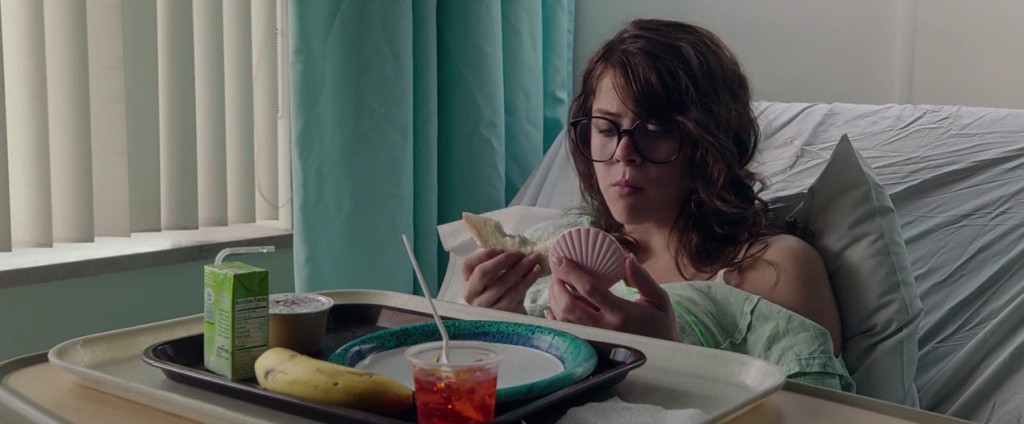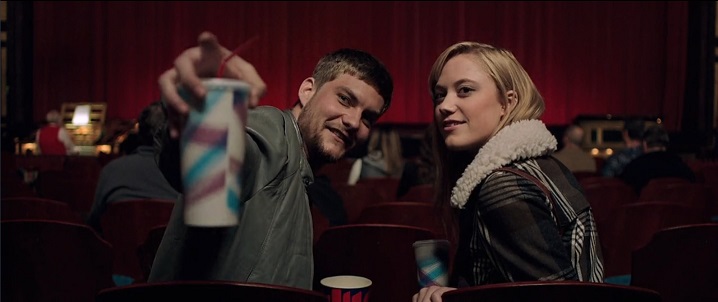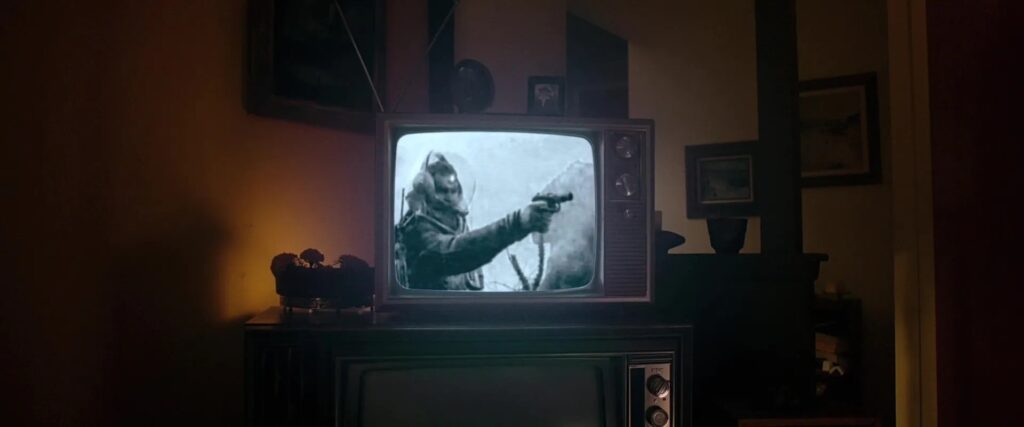|Chris Polley|

It Follows plays at the Trylon Cinema from Friday, October 4th, through Sunday, October 6th. Visit trylon.org for tickets and more information.
I was lucky enough to see David Robert Mitchell’s It Follows in the theater when it was originally released a little under 10 years ago today. At a movie theater that no longer exists, playing hooky from work after lunch but before daycare closed, I was already a bit anxious, being a goody two-shoes that never really did such a thing. At the time, my first and only child was not even three years old, and I was wracked with guilt over choosing a horror film instead of picking my son up early or, you know, going back to my job. But I nevertheless felt magnetically drawn toward the choice that let me taste a semblance of freedom during a time where I felt pressure to do for others on either side of my commute. The dread and the thrill was poetic and perfect for the particular feature presentation I treated myself to on that cold Friday afternoon. And I can’t imagine I’m the only working parent who’s ever felt this way, taking advantage of a temporary break from the stress, even if it comes with its own baggage that lingers.
The monster at the heart of It Follows is also a timeless paradox: college-aged kids stuck in a suburban milieu have casual one-night stands in an attempt to take control of their lives and feel a momentary rush in the midst of their boring, decaying town, but when they do, they invite unending slow-moving horror that only goes away if they inflict it on someone else. (I would say it’s like a sick, twisted version of Pay It Forward, but that movie already has Kevin Spacey in it). “In the postmodern horror film, loss of control pertains also to the power of the media over how we perceive and make sense of the world, the power of the media to fabricate reality,” wrote Andrew Syder in a 2002 issue of Spectator.1 This is where It Follows deviates so boldly and drastically from nearly every other scary movie that involves young adults, unprotected sex, and imminent doom. It’s not your average treatise on the recklessness of youth or the dark underbellies of suburbia; rather, Mitchell sneakily embeds an oblique otherworldliness in a film that otherwise presents itself on the surface as ordinary.

Lead character Jay goes on a date with a guy (who we find out later is using a fake name) to see Stanley Donen’s 1963 romantic caper Charade (about a man who keeps changing his name) at a vintage movie theater that features a pre-showtime organist with nary a smart phone in sight. Jay, her sister Kelly, and their friends watch Christian Nyby’s 1951 sci-fi classic The Thing from Another World on a late-70s-style tube television (which sits atop an even older, more ornamental model) while Jay and Kelly’s mom stares into the middle distance seated at the adjacent retro-kitchenette. Linda A. Liu spoke at the Society for Cinema and Media Studies Conference on the film, remarking, “Various outmoded objects throughout the film point to the inability of Jay’s single-mother-headed household to keep up with contemporary consumption cycles.”2 This is where it becomes clear that the film’s setting is not just an aesthetic—it’s a self-aware, autobiographically resonant choice. Specifically, this is the same lower-middle class neighborhood outside Detroit where David Robert Mitchell grew up and saw this kind of life first-hand. Anachronisms weren’t as much kitsch as they were simply holdovers from a bygone era.

This is, of course, all without even mentioning the actual horror that occurs and hovers constantly—an ever-changing specter of death more so than a parade of death itself. When it arrives, plodding along in its zombie state, stalking Jay (who has been infected by way of her aforementioned date) as she attempts to elude it with the help of her sister and friends, it presents itself less as a bloodied, gory George Romero extra and more often as a half-drowned, sad kind of thing. Sometimes in forms familiar (a parent or a known peeping tom) and sometimes not, whatever it is—it’s gross and all other characteristics of it are unknown. As Mark Jancovich wrote in his seminal text Horror: The Film Reader, “disgust is required for the pleasure involved in engaging our curiosity in the unknown and drawing it into the processes of revelation.”3 There is no ancient text of curses, or lifelong vendetta, or any of the overused tropes that typically offer reason for a killer’s raison d’être. Instead, it’s repulsive and free of context, other than what its victims can discern by pattern or persuasion. Like the props and sets of the movie, the undefinable monster could easily be either five days or five centuries old.
“My basic idea was of a horror film where the fear came from something that is so slow, that you can somehow escape from, but the fact that it’s relentless and eternal,” Mitchell said in a 2015 interview with The Playlist.4 And that’s ultimately what is most terrifying—a death that is always happening, coming from all directions. It’s not a coincidence, then, that a quiet cornerstone of the bag of tricks and motifs within It Follows is the looming screen in its various forms: cinema, TV, and, in perhaps most memorably, an idiosyncratic clamshell-shaped e-reader that looks like a cross between a Nintendo DS and a makeup compact that Mitchell conjured up just for the film (further adding to the film’s intentionally confused sense of place). Get past the gadget’s one-of-a-kindness, though, and pay attention to what Jay’s friend Yara is reading on it to gain some possible thematic insight: Fyodor Dostoevsky’s The Idiot.
Staunchly anti-capital punishment, and himself a survivor of a public execution (at the last second, his sentence was commuted to hard labor) in the wake of his involvement in a movement that opposed Russia’s tsarist regime, Dostoevsky imagines in his novel a good but simple man who is routinely haunted by the cruelty of the world around him, including its thirst for death on display. Similarly, in It Follows, Jay is a good but simple young woman who is routinely haunted by the cruelty of the world around her, and is, well, ever on the brink of death and on display for us, the viewer. “The moving frame lines of the panning camera are concealing our vision from the very thing we are trying to looking out for,” Archie Marshall commented when deconstructing the cinematography of It Follows for Film Daze.5 This deconstructionist view of the film suggests the infinite nature of humanity’s dread as well as the conversely finite nature of humanity’s ability to survive an unforgiving earth.
In fact, that ironically inhuman nature reveals another monster at the other end of the proverbial refracted stream of flickering light. Discussing the ethos Mitchell and his crew were going for, Director of Photography Mike Gioulakis said to Filmmaker Magazine, “we wanted to take the human presence away from the camerawork as much as possible and have it be sterile and robotic.”6 More than just surveillance, the titular “it” of the film is both lens and projector—watcher and amplifier. Mitchell dreamed it up because of what he’s seen, and now he’s passing it on to us.
And I was drawn to the theater that day in early 2015 to avoid facing my responsibilities but also to bask in the glow of the (digital) celluloid, and so many of us have rewatched the movie multiple times in the decade since, and now the Trylon and I are passing the curse onto you—ad infinitum.
- Andrew Syder, “Knowing the Rules: Postmodernism and the Horror Film,” Spectator 22 No. 2 (Fall 2002): 78-88. ↩︎
- Linda A. Liu, “Out of Time: The Uses of Anachronism in It Follows,” Society for Cinema and Media Studies Conference. March 31, 2016. ↩︎
- Mark Jancovich, Horror: The Film Reader (London: Routledge, 2002), 37. ↩︎
- Charlie Schmidlin, “Interview: David Robert Mitchell Talks The Mood Of ‘It Follows,’ Building A Unique Horror Movie, And More,” The Playlist. March 10, 2015. ↩︎
- Archie Marshall, “‘IT’S BEHIND YOU!’ – The fear of the unknown in ‘It Follows’,” Film Daze. October 27, 2021. ↩︎
- Matt Mulcahey, “‘We Didn’t Have to Add Too Much Creepiness’: It Follows DP Mike Gioulakis,” Filmmaker. March 31, 2015. ↩︎
Edited by Matthew Tchepikova-Treon
